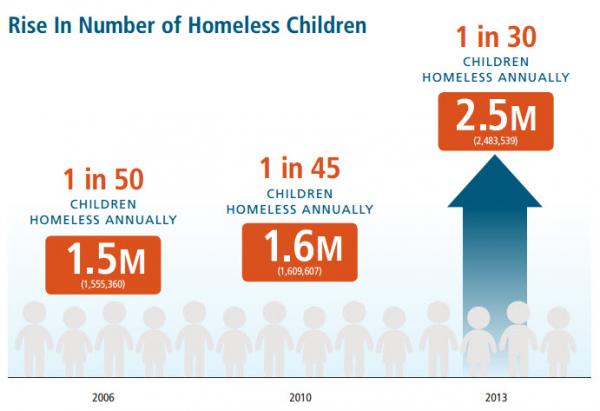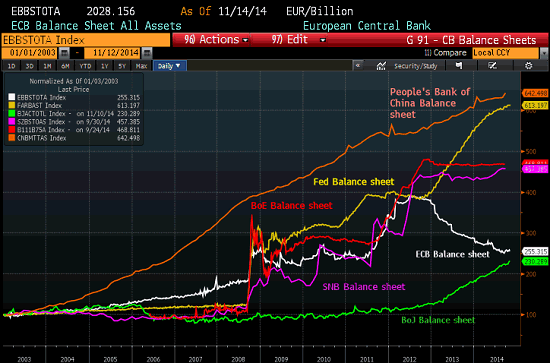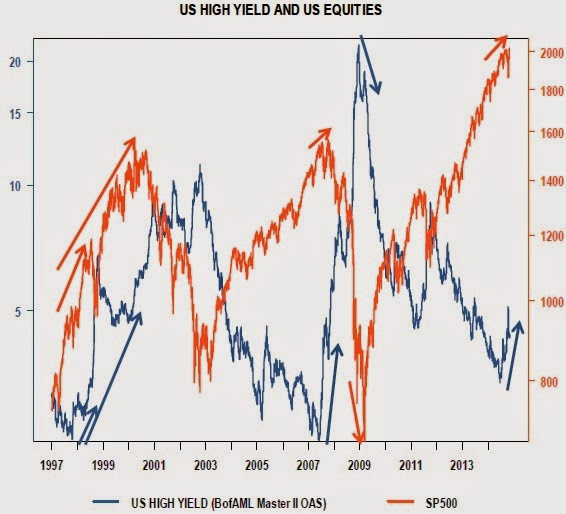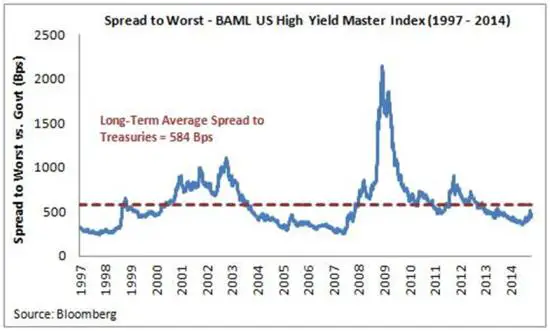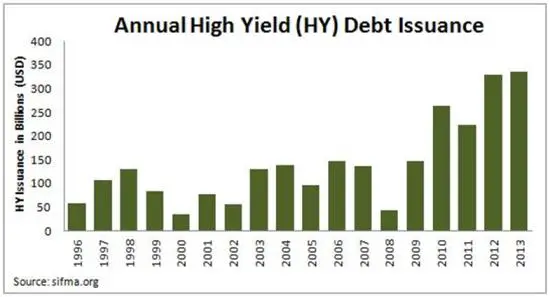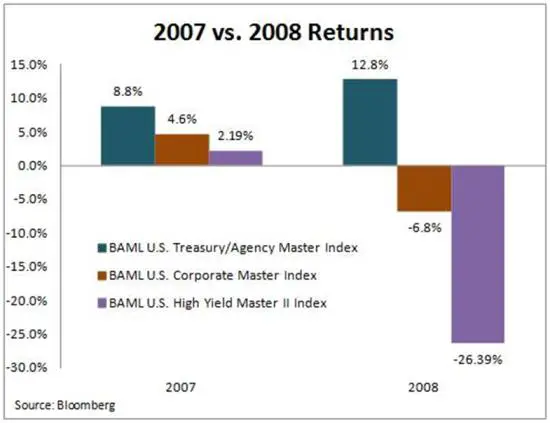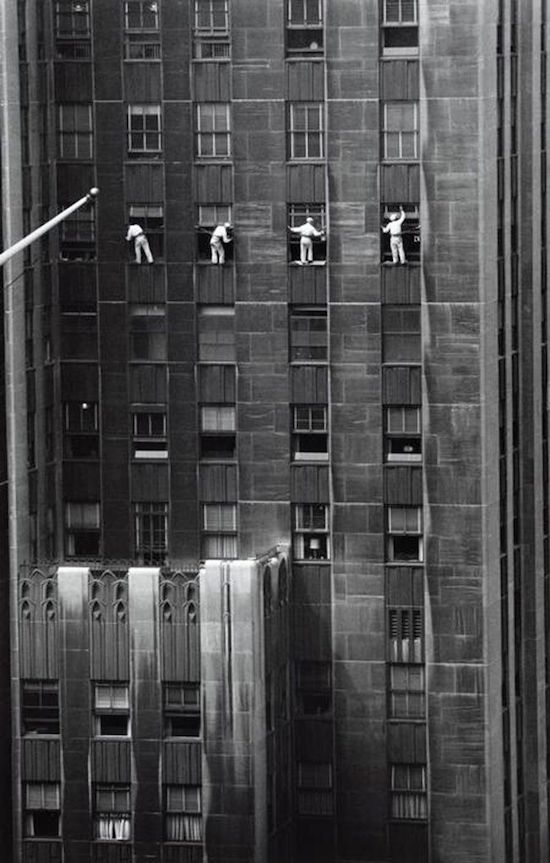
Inge Morath Window washers 1958

Probably nothing…
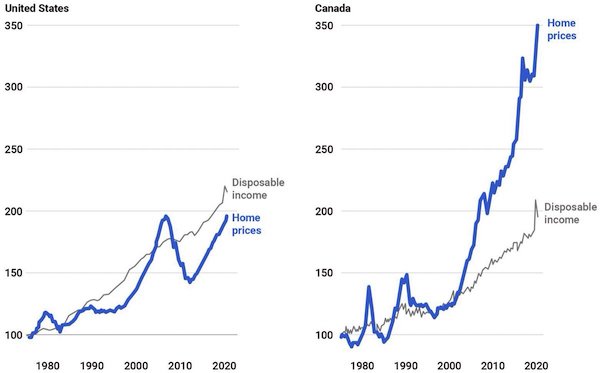

You were told to
https://twitter.com/i/status/1512323263011119105

It’s not about health, it’s about a treaty we signed…
Australia… Senator Gerard Rennick catches out the Australian Health Minister… It seems the mandate to stop the unvaccinated leaving Australia has nothing to do with health… it’s foreign interference, they signed an international treaty… pic.twitter.com/JN589AW65w
— Pelham (@Resist_05) April 6, 2022

Michael Burry was censored over this Tweet.
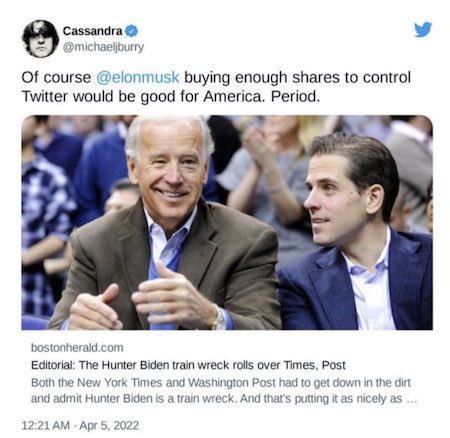

Google Translate. Not to be missed.
Jacques Baud is a Former Colonel of the General Staff, former member of Swiss strategic intelligence, specialist in Eastern European countries.
• The Military Situation In Ukraine (Jacques Baud)
We have to go back to March 24, 2021. On that day, Volodymyr Zelensky issued a decree for the reconquest of Crimea and began to deploy his forces towards the south of the country. Simultaneously, several NATO exercises were conductedbetween the Black Sea and the Baltic Sea, accompanied by a significant increase in reconnaissance flights along the Russian border. Russia then conducts a few exercises to test the operational readiness of its troops and show that it is following the evolution of the situation. Things calm down until October-November with the end of the ZAPAD 21 exercises, whose troop movements are interpreted as a reinforcement for an offensive against Ukraine. However, even the Ukrainian authorities refute the idea of Russian preparations for a war and Oleksiy Reznikov, Ukrainian Minister of Defense declares that there has been no change on its border since the spring.
In violation of the Minsk Accords, Ukraine is conducting aerial operations in Donbass using drones, including at least one strike against a fuel depot in Donetsk in October 2021 . The American press points this out, but not the Europeans and no one condemns these violations. In February 2022, events rush. On February 7, during his visit to Moscow, Emmanuel Macron reaffirms to Vladimir Putin his attachment to the Minsk Accords , a commitment he will repeat after his interview with Volodymyr Zelensky the next day. But on February 11, in Berlin, after 9 hours of work, the meeting of the political advisers of the leaders of the ” Normandy format ” ends, without concrete result: the Ukrainians still and always refuse to apply the Accordsof Minsk, apparently under pressure from the United States. Vladimir Putin then notes that Macron has made empty promises to him and that the West is not ready to enforce the Accords, as they have been doing for eight years.
Ukrainian preparations in the contact zone continue. The Russian Parliament is alarmed and on February 15 asks Vladimir Putin to recognize the independence of the Republics, which he refuses. On February 17, President Joe Biden announces that Russia will attack Ukraine in the coming days. How does he know? Mystery& But since the 16th, the artillery shelling of the populations of Donbass has increased dramatically, as shown by the daily reports of OSCE observers. Naturally, neither the media, nor the European Union, nor NATO, nor any Western government reacts and intervenes. We will say later that this is Russian disinformation. In fact, it seems that the European Union and some countries purposely glossed over the massacre of the people of Donbass, knowing that it would provoke Russian intervention.
At the same time, there are reports of acts of sabotage in the Donbass. On January 18, Donbass fighters intercept saboteurs equipped with Western equipment and speaking Polish seeking to create chemical incidents in Gorlivka . They could be CIA mercenaries , led or “advised” by Americans and made up of Ukrainian or European fighters, to carry out sabotage actions in the Donbass Republics.
[..] The Russian offensive proceeds in a very “classic” manner. At first – as the Israelis had done in 1967 – with the destruction on the ground of the air forces in the very first hours. Then, we witness a simultaneous progression on several axes according to the principle of “flowing water”: we advance wherever resistance is weak and we leave the cities (very voracious in troops) for later. To the north, the Chernobyl plant is occupied immediately to prevent acts of sabotage. The images of Ukrainian and Russian soldiers jointly guarding the plant are naturally not shown… The idea that Russia is trying to take over Kiev, the capital, to eliminate Zelensky, typically comes from the West: this is what they did in Afghanistan, Iraq, Libya and what they wanted to do in Syria with the help of the Islamic State .
But Vladimir Putin never intended to take down or overthrow Zelensky. On the contrary, Russia seeks to keep him in power by pushing him to negotiate by encircling kyiv. He had refused to do so far to apply the Minsk Accords, but now the Russians want to obtain Ukraine’s neutrality. Many Western commentators marveled that the Russians continued to seek a negotiated solution while conducting military operations. The explanation is in the Russian strategic conception, since Soviet times. For Westerners, war begins when politics ceases. However, the Russian approach follows a Clausewitzian inspiration: war is the continuity of politics and one can pass fluidly from one to the other, even during combat. This creates pressure on the opponent and pushes him to negotiate.
From an operational point of view, the Russian offensive was an example of its kind: in six days, the Russians seized a territory as vast as the United Kingdom, with a speed of advance greater than what the Wehrmacht made in 1940. The bulk of the Ukrainian army was deployed in the south of the country for a major operation against Donbass. This is why the Russian forces were able to encircle it from the beginning of March in the “cauldron” between Slavyansk, Kramatorsk and Severodonetsk, by a thrust coming from the east via Kharkov and another coming from the south from the Crimea. The troops of the Republics of Donetsk (DPR) and Lugansk (RPL) complete the action of the Russian forces with a push from the East.
At this stage, the Russian forces are slowly tightening the noose, but are no longer under time pressure. Their objective of demilitarization is practically achieved and the residual Ukrainian forces no longer have an operational and strategic command structure. The “slowdown” that our “experts” attribute to poor logistics is only the consequence of having achieved the objectives set. Russia does not seem to want to engage in an occupation of the whole Ukrainian territory. In fact, it seems rather that Russia is trying to limit its advance to the country’s linguistic border.
Jacques Baud is a former Colonel of the General Staff, former member of Swiss strategic intelligence, specialist in Eastern European countries. He was trained in the American and British intelligence services. He was the head of doctrine for United Nations peace operations. A United Nations expert for the rule of law and security institutions, he designed and led the first multidimensional United Nations intelligence service in Sudan. He worked for the African Union and was responsible for the fight against the proliferation of small arms at NATO for 5 years. He was engaged in talks with top Russian military and intelligence officials right after the fall of the USSR. Within NATO, he followed the Ukrainian crisis of 2014, then participated in programs of assistance to Ukraine. He is the author of several books on intelligence, war and terrorism, and in particular Le Détournement published by SIGEST, Govern by fake news, The Navalny affair, and Poutine, master of the game? published by Max Milo.

Pushing regime change in a country of 220 million people. Which is a nuclear power.
• Pakistani Prime Minister Imran Khan Ousted By Parliament (PD)
Pakistan’s parliament passed a no-confidence motion against Prime Minister Imran Khan in the early hours of Sunday April 10. Sunday’s vote took place one week after Khan had dissolved parliament in order to avoid the no-confidence motion, citing foreign interference. The Supreme on Thursday April 7 ruled that the move was illegal and that the parliament must be restored. The vote against Khan of the Pakistan Tehreek-e-Insaf (PTI) party on April 10 was promoted by legislators from the Pakistan Muslim League Nawaz (PML-N) and other parties) and the Pakistan People’s Party (PPP) and received 174 votes in favor, two more than the necessary 172 to be passed. The session was chaired by Ayaz Sadiq of PML-N after the National Assembly Speaker Asad Qaiser resigned from his post.
Qaiser stated that he could not take part in a foreign conspiracy to oust the prime minister, “In line with our laws and the need to stand for our country, I have decided that I can’t remain on the position of speaker and thereby resign.” When the no-confidence measure was first raised Khan had warned that it was product of an international conspiracy and alleged US involvement. While US officials denied any involvement, many have raised suspicion that the move gained strength just as Pakistan began to distance itself from Washington’s diktats. Since the Taliban take over the government of Afghanistan in August and the complete isolation of the country by the US and its allies, Pakistan has been one of the only countries engaging in economic and political relations with the government as the country faces a humanitarian crisis.
Further, it has not fallen into line with the US regarding Russia and has continued to conduct lifesaving trade and has refused to economically and politically marginalize the superpower. Khan denounced a joint letter issued by 22 European countries urging Pakistan to support a resolution in the United Nations General Assembly condemning Russia’s aggression against Ukraine. He declared at a public rally: “Are we slaves and do whatever you tell us… We are neutral in this conflict and will support those who want to end the war in Ukraine.” With the success of the no-confidence measure, Khan will be forced to step down. No democratically elected government has completed a full term since the creation of Pakistan in 1947. Khan’s removal comes amid a growing economic crisis due to global inflation. Prices of essential items such as cooking oil, grains, wheat, and sugar have all increased. Khan’s government turned to the International Monetary Fund (IMF) for support and had entered a stalemate with the institution which was demanding strict conditions and austerity policies.

Two parts from one article by Pepe Escobar.
• The Total War to Cancel Russia (Escobar)
By now it’s abundantly clear that the neo-Orwellian “Two Minute Hate” Russophobic campaign launched by the Empire of Lies after the start of Operation Z is actually “24/7 Hate”. Vast swathes of NATOstan have been corralled into behaving like a Russophobic lynch mob. No dissent is tolerated. The full psyops has de facto upgraded the Empire of Lies to the status of Empire of Hate in a Total War – hybrid and otherwise – to cancel Russia. Hate, after all, packs way more punch than mere lies, which are now veering into abject ridiculousness, as in U.S. “intelligence” resorting to – what else – lies to fight the info war against Russia. If the propaganda overdrive has been lethally effective amidst the zombified Western masses – call it a “win” in the P.R. war – in the front where it really matters, inside Russia, it’s a major fail.
Public opinion support for both Operation Z and President Putin is unprecedented. After videos of torture of Russian POWs that caused widespread revulsion, Russian civil society is even bracing for a “Long War” lasting months, not weeks, as long as the targets of the Russian High Command – actually a military secret – are met. The stated aims are “demilitarization” and “denazification” of a future neutral Ukraine – but geopolitically reach way beyond: the aim is to turn the post-1945 European collective security arrangement upside down, forcing NATO to understand and come to terms with the concept of “indivisible security”. This is an extremely complex process that will reach the next decade.
The NATOstan sphere simply cannot admit in public a series of facts that a military analyst of the caliber of Andrei Martyanov has been explaining for years. And that adds to their collective pain. Russia can take on NATO and smash it to bits in 48 hours. It may employ advanced strategic deterrence systems unmatched across the West. Its southern axis – from the Caucasus and West Asia to Central Asia – is fully stabilized. And if the going gets really tough, Mr. Zircon can deliver his hypersonic nuclear business card with the other side not even knowing what hit it. It may be enlightening to see how these complex processes are interpreted by Russians – whose points of view are now completely blocked across NATOstan.
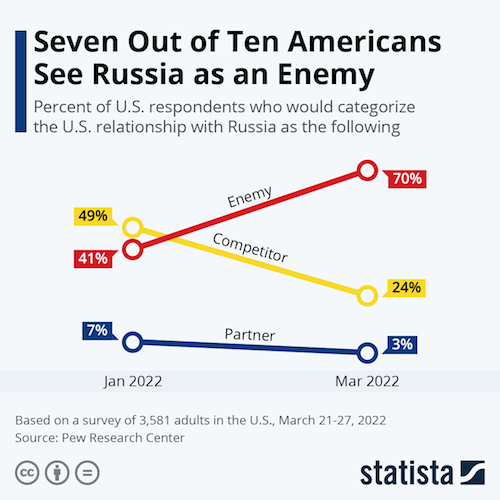

“What you are seeing now is the death of Europe. Even if it does not come to nuclear strikes on industrial centers, Europe is doomed..”
• “Europe Has Chosen Its Fate” (Escobar)
It may be enlightening to see how these complex processes are interpreted by Russians – whose points of view are now completely blocked across NATOstan. Let’s take two examples. The first is Lieutenant General L.P. Reshetnikov, in an analytical note examining facts of the ground war. Some key takeaways: – “Over Romania and Poland there are airborne early warning aircraft of NATO with experienced crews, there are U.S. intelligence satellites in the sky all the time. I remind you that just in terms of budgets for our Roscosmos we allocated $2.5 billion a year, the civil budget of NASA is $25 billion, the civil budget of SpaceX alone is equal to Roscosmos – and that is not counting the tens of billions of dollars annually for the entire U.S. feverishly unfolding the control system of the entire planet.” – The war is unfolding according to “NATO’s eyes and brains. The Ukronazis are nothing but free controlled zombies. And the Ukrainian army is a remotely controlled zombie organism.”
– “The tactics and strategy of this war will be the subject of textbooks for military academies around the world. Once again: the Russian army is smashing a Nazi zombie organism, fully integrated with the eyes and brain of NATO.” Now let’s switch to Oleg Makarenko, who focuses on the Big Picture. – “The West considers itself ‘the whole world’ only because it has not yet received a sufficiently sensitive punch on the nose. It just so happened that Russia is now giving him this click: with the rear support of Asia, Africa and Latin America. And the West can do absolutely nothing with us, since it also lags behind us in terms of the number of nuclear warheads.” – “Europe has chosen its fate. And chose fate for Russia. What you are seeing now is the death of Europe. Even if it does not come to nuclear strikes on industrial centers, Europe is doomed.
In a situation where European industry is left without cheap Russian energy sources and raw materials – and China will begin to receive these same energy carriers and raw materials at a discount, there can be no talk of any real competition with China from Europe. As a result, literally everything will collapse there – after industry, agriculture will collapse, welfare and social security will collapse, hunger, banditry and chaos will begin.” It’s fair to consider Reshetnikov and Makarenko as faithfully representing the overall Russian sentiment, which interprets the crude Bucha false flag as a cover to obscure the Ukrainian army torture of Russian POWs.
And, deeper still, Bucha allowed the disappearance of Pentagon bioweapon labs from the Western mediasphere, complete with its ramifications: evidence of a concerted American drive to ultimately deploy real weapons of mass destruction against Russia. The multi-level Bucha hoax had to include the Brit presidency of the UN Security Council actually blocking a serious discussion, a day before the Russian Ministry of Defense struggled to present to the UN – predictably minus the U.S. and the UK – all the bioweapon facts they have unearthed in Ukraine. The Chinese were horrified by the findings.

That’s most of the world. And its resources.
• BRICS Ministers of Finance Hold a Meeting (CTH)
This is not some grand conspiracy, ‘out there‘ deep geopolitical possibility, or foreboding likelihood as an outcome of short-sighted western emotion. No, this is just a predictable outcome from western created events that pushed specific countries to a natural conclusion based on their best interests. You can debate the motives of the western leaders who structured the sanctions against Russia, and whether they knew the outcome would happen as a consequence of their effort, but the outcome was never really in doubt. Personally, I believe this outcome is what the west intended. The people inside the World Economic Forum are not stupid – ideological, yes, but not stupid. They knew this would happen.
The finance ministers of the BRICS alliance (Brazil, Russia, India, China and South Africa) have decided to create their own financial mechanisms to continue trade between nations of similar disposition. Once the internal issues inside the BRICS alliance are resolved, and once the mechanisms are created, then other nations will be able to decide to join or not. The great global cleaving will commence. [..] The bottom line is – the 2022 punitive economic and financial sanctions by the western nations’ alliance against Russia was exactly the reason why BRICS assembled in the first place. The multinational corporate control of government is exactly what the BRICS assembly foresaw when they first assembled during the Obama administration. When multinational corporations run the policy of western government, there is going to be a problem.
In the bigger picture, the BRICS assembly are essentially leaders who do not want corporations and multinational banks running their government. BRICS leaders want their government running their government; and yes, that means whatever form of government that exists in their nation, even if it is communist. BRICS leaders are aligned as anti-corporatist. That doesn’t necessarily make those government leaders better stewards, it simply means they want to make the decisions, and they do not want corporations to become more powerful than they are. As a result, if you really boil it down to the common denominator, what you find is the BRICS group are the opposing element to the World Economic Forum assembly. The countries run by multinational corporations are in Yellow, the countries who have not yet chosen a side are in GREY:
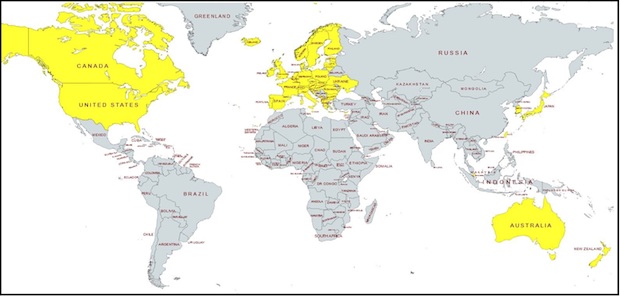

“It will be clear to everyone that the supposed effectiveness of sanctions is an absolute lie.”
• Russia Urges BRICS Nations To Create Own ‘SWIFT’ System (ZH)
The dollar reserve system is facing its greatest threat yet. Russian Finance Minister Anatoly Siluanov said on Saturday that the five BRICS countries – Brazil, Russia, India, China and South Africa – could mitigate the backlash of Western sanctions against Russia on their economies by pooling their efforts and using a range of financial instruments at their disposal. “The current crisis is man-made and BRICS countries have all the instruments necessary to mitigate its consequences for the national and global economies,” Siluanov was cited as saying by the Russian Finance Ministry. The minister blamed economic sanctions on Russia for “destroying the foundation of the existing international monetary and financial system based on the US dollar” and urged BRICS to rely more on their national currencies in foreign trade, integrate payment systems and create an alternative to the SWIFT payment messaging platform.
Siluanov on Friday told a ministerial meeting with BRICS that the global economic situation had worsened substantially due to the sanctions, a statement from his ministry said on Friday. “This pushes us to the need to speed up work in the following areas: the use of national currencies for export-import operations, the integration of payment systems and cards, our own financial messaging system and the creation of an independent BRICS rating agency,” Siluanov said. As The Statesman reports, central banks of the BRICS countries have already agreed to conduct the fifth test of a banking mechanism that will allow them to jointly pool “alternative currency” reserves to shield their economies from outside shocks, the ministry said.
Siluanov’s comments echoed Dmitry Medvedev’s comments on Telegram. The Deputy Head of Russia’s Security Council warned of the geopolitical consequences of Western sanctions and the weaponization of the US dollar reserve system: “Their result will be a destroyed international order and extremely difficult consequences for the world economy and the life of individual countries,” adding that: “It will be clear to everyone that the supposed effectiveness of sanctions is an absolute lie.”

“I won’t have any faith in him,” [Ron] Johnson said of a special counsel.”
• Support Grows Among Republicans For Hunter Biden Special Counsel (JTN)
Nearly 100 House Republicans are urging Attorney General Merrick Garland to appoint a special counsel to investigate Hunter Biden’s foreign business deals, saying they had the hallmarks of an influence peddling scandal. The letter led by Reps. Tom Rice (R-S.C.) and Jim Banks (R-Ind.), the chair of the House GOP Study Committee, comes as the U.S. attorney in Delaware enters his third year investigating Hunter Biden’s taxes, foreign lobbying and money movements. In all, 95 House GOP members signed the letter. “It is increasingly clear that Hunter Biden took advantage of his father’s position as Vice President to develop business relationships with clients in Ukraine, China, and Kazakhstan,” the lawmakers wrote.
“Hunter Biden likely facilitated lobbying for foreign entities through third-party channels without registering for the Foreign Agents Registration Act. “It appears that Hunter Biden used his position as son of then-Vice President Biden to gain wealth and influence in foreign countries, using questionably sourced money to pay tax liabilities, and lobbying on behalf of foreign entities without proceeding through the proper channels.” The House Republicans said they were concerned DOJ “has an actual conflict of interest and certainly has the appearance of a conflict of interest that could prevent a fair and impartial investigation of his activities.” “We believe that in the case of Hunter Biden a special counsel must be appointed to preserve the integrity of this investigation and any subsequent prosecution.
A special counsel would also ensure there is no bias in the investigation or undue influence from the White House,” the lawmakers added. [..] While support for a special counsel has been growing, some Republicans like Sen. Ron Johnson argue it isn’t necessary and would only further delay an already slow moving investigation. “I won’t have any faith in him,” Johnson said of a special counsel.


No investigation of Hunter can be complete without investigating Joe.
• $54M in Chinese Gifts Donated To UPenn, Home of Biden Center (NYP)
A government watchdog is demanding the US Attorney probing Hunter Biden in Delaware investigate tens of millions in anonymous donations from China to the University of Pennsylvania, where an academic center is named for his father, President Biden. The Ivy League college raked in a total of $54.6 million from 2014 through June 2019 in donations from China, including $23.1 million in anonymous gifts starting in 2016, according to public records. Most of the anonymous donations came after the university announced in February 2017 that it would create the Penn Biden Center for Diplomacy and Global Engagement. Joe Biden, whose term as vice president had just ended, was to lead the center and was also named a professor at the university. The center, which is located in Washington, DC., opened its doors in February 2018.
Antony Blinken, whom Biden named as Secretary of State, briefly served as its managing director. The Ivy League university received $15.8 million in anonymous Chinese gifts that year, including one eye-popping $14.5 million donation in May 2018, records show. The flurry of donations may be related to Hunter Biden’s business interests in China, the National Legal and Policy Center, a Virginia-based watchdog, alleged in complaints sent in May and October 2020 to the Departments of Education and Justice. Last week, the group asked US Attorney David Weiss to step in and investigate the Chinese largesse to the school as part of his federal tax probe of Hunter Biden. “We’ve asked … Weiss to pursue the larger network of individuals and institutions who benefited from millions doled out by foreign interests connected to Hunter Biden’s work in China and Ukraine,” said Tom Anderson, director of the NLPC’s Government Integrity Project.
In its 12-page complaint, the watchdog cited a 2017 text found on Hunter Biden’s infamous laptop that CEFC China Energy Co, one of the firms that Hunter Biden had a financial stake in, wanted to lobby politicians in the US but did not want to register under the Foreign Agent Registration Act (FARA), required for all foreign lobbyists. “We don’t want to have to register as foreign agents under the FCPA [sic] which … is much more expansive than people who should know choose not to know,” reads the May 1, 2017, text sent from Hunter Biden to his former business partner Tony Bobulinski.

“..Moscow’s military annexation of Ukraine’s Crimean region in 2014 was a wild card that could scuttle the success of their business pursuits..”
Oh, and definition counts: There was a 1st war on Ukraine? Was that when Ukraine invaded the Donbass?
• Hunter Biden Sought Oligarchs’ Cash In 1st Russian War On Ukraine (JTN)
In the shadows of Russia’s first invasion of Ukraine in 2014, Hunter Biden and his business partners embarked on an aggressive campaign to score millions of dollars in “life changing” business with oligarchs in both countries who had an interest in his father’s policymaking business, according to emails and court records obtained by Just the News. President Joe Biden’s son and his associates targeted Russian oligarch Yelena Baturina — who eventually was sanctioned by the U.S. a few years later in 2018 — for as much as $200 million after helping her get a bank account set up in America, the emails show. Hunter Biden and his associates even arranged for Baturina and her husband, an ex-Moscow mayor, to meet with then-Vice President Joe Biden at an intimate dinner in Washington in 2015.
At the same time he and his team courted Baturina, Hunter Biden was securing lucrative board positions and consulting deals with Ukrainian oligarch Mykola Zlochevsky, a man whose company, Burisma Holdings, the United States and Great Britain wanted investigated for corruption. The delicate balancing act of cashing in on both the Russian and Ukrainian sides of the conflict left the younger Biden and his partners acutely aware that Moscow’s military annexation of Ukraine’s Crimean region in 2014 was a wild card that could scuttle the success of their business pursuits, the memos show.
“Just spent two hours on the phone with Kiev. I am confident at this point that this is a good if not life changing deal if the Uk [Ukraine] doesn’t collapse in the meantime,” now-convicted Biden business partner Devon Archer wrote Hunter Biden in one particularly candid assessment of their strategy in mid-April 2014. Eventually, another of Hunter Biden’s convicted business associates, John Galanis, would declare in a sworn affidavit to a federal court that he and his son Jason became aware of a strategy by Hunter Biden-related companies of promising oligarchs “quid pro quo” access to Washington in return for their dollars. “Jason Galanis gave his interest in Burnham/Wealth Assurance to Archer on the prospect that Archer and Hunter Biden would continue to attract foreign oligarchs on the promise of high level political contacts,” John Galanis swore in a January 2020 affidavit that unequivocally referred to the scheme as “political influence peddling.”

Sussmann will be fun.
• Durham Evidence: Relentless Democrat Effort To Sell Russia Collusion Hoax (JTN)
As the trial for former Hillary Clinton campaign lawyer Michael Sussmann draws closer, Special Counsel John Durham is painting a picture of a relentless effort by Democrat operatives to sell the Russia collusion narrative across the U.S. government from the FBI to the State Department. Essentially, Hillary Clinton operatives flooded the zone in the summer and fall of 2016, hoping multiple Trump collusion allegations circulating inside the government agencies might prompt an investigation and media interest. For the first time this week, Durham called it a “joint venture” and a conspiracy to shop unproven Trump dirt.
In the case of Sussmann, Durham alleges that effort involved deceit by lying to the FBI that he did not have a client when he presented (since-discredited) evidence to the FBI that Donald Trump had a secret computer back channel at the Alfa Bank in Moscow to talk with the Kremlin. In fact, Sussmann was working on behalf of the Clinton campaign and a tech executive named Rodney Jaffe who was aligned with the campaign when he approached the FBI in September 2016 and made the anti-Trump allegations, Durham’s team alleges. A few months later, prosecutors say, Sussmann was still representing the tech executive when he approached the CIA in February 2017 to get the spy agency involved and again claimed he wasn’t representing a client’s interest.
On Monday, Durham showed the strength of his evidence of Sussmann’s alleged lie: He offered the handwritten notes of two senior FBI officials who recorded that the Clinton lawyer had said he was not acting on behalf of a client when he reported the Trump dirt. “Said not doing this for any client,” then-Assistant FBI Director for Counterintelligence Bill Priestap wrote in his notes, recording what Sussmann had told him. A deputy general counsel wrote a similar notation.

“..it’s living in a space that’s not exactly a publication, but it’s not exactly a private company either… That’s why it’s so tricky.”
• Bill Maher Cheers On Elon Musk Joining Twitter (Fox)
“Real Time” host Bill Maher offered enthusiastic support for Tesla CEO Elon Musk as he joins Twitter. Musk shocked the world this week when it was revealed he purchased 9.2% stake in Twitter, Inc., making him the largest shareholder in the social media giant. He made even more headlines when it was announced that he was joining Twitter’s board of directors, suggesting he could have influence over Twitter’s policies in favor of free speech principles. During Friday’s “Overtime” segment on YouTube, a viewer submitted a question asking, “What’s the panel’s thoughts on Elon Musk becoming Twitter’s single-largest shareholder. “I’m for it!” Maher exclaimed while pounding the table. New York Times writer David Leonhardt said his reaction to the Elon Musk news was, “Are we gonna have to read Donald Trump’s tweets again soon.”
“Which is a tough one,” Maher reacted. “Because once they took Trump off Twitter, things did get better but it’s… bad for free speech. And then they’re gonna go somewhere. And then the resentment and then the idea, ‘Well, you know, the people who are ganging up against us- the media and Big Tech and Big Government. I mean, that’s the convoy. You know, those convoys in Canada and all over the world.” Liberal author Nancy MacLean pushed back against Maher, arguing that Twitter’s censorship of Trump is not in violation of the Constitution since the First Amendment only applies to the government suppressing free speech, not private companies. “We live in a different age where Twitter is the public square now. If you deny someone’s right to speak on Twitter, you’re basically saying you don’t have free speech rights,” Maher said. “We’re not living in 1980 anymore. This is a different world we live in where social media controls this. So social media is sort of a… it’s living in a space that’s not exactly a publication, but it’s not exactly a private company either… That’s why it’s so tricky.”
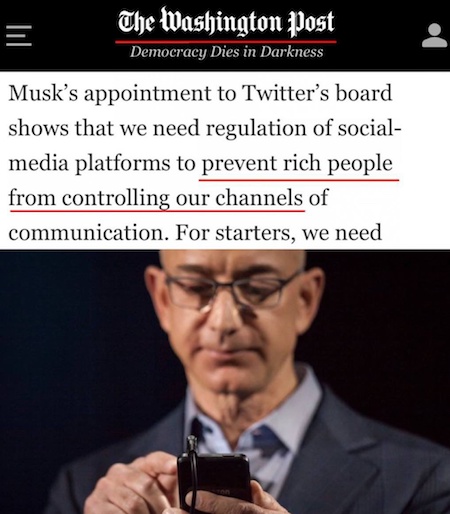






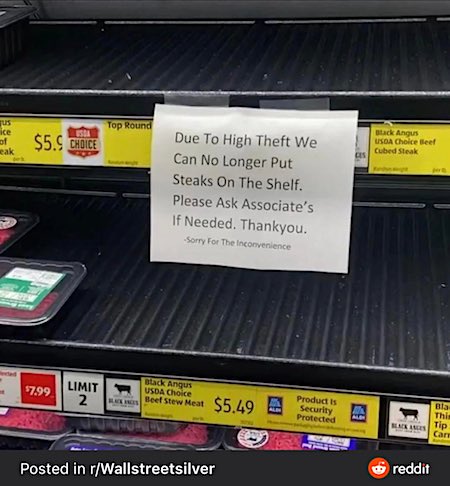

Zelenko
Dr. Zelenko – alarming pic.twitter.com/MbLS7UR8zQ
— Zola (@betterworld_22) April 9, 2022

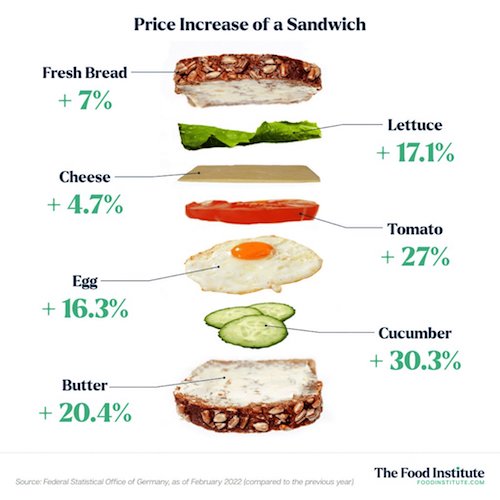

Makary
Johns Hopkins' Dr. Marty Makary on more boosters & the politicization of the CDC:
"The head of the CDC ignoring natural immunity is like having the head of NASA believe the earth is flat."
"You cannot keep pumping boosters in people every three to six months in perpetuity …" pic.twitter.com/WWrMUCW2gz
— Scott Morefield (@SKMorefield) April 9, 2022

Support the Automatic Earth in virustime with Paypal, Bitcoin and Patreon.






